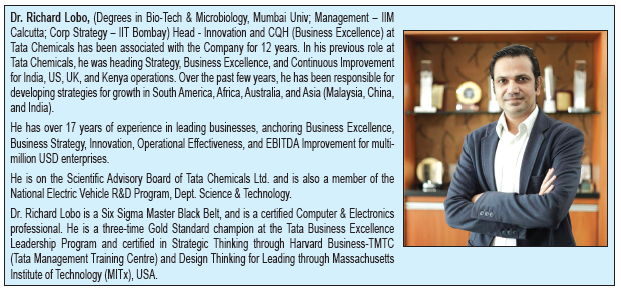This pandemic has reiterated the dire importance of innovation for combating a virulent virus that virtually held the entire world to ransom. R&D efforts globally succeeded in coming up with a handful of vaccines in a short time. India therefore recognises the importance of R&D like never before. Countries like Korea and Taiwan have got on to big league economies by leveraging R&D. India has a very good R&D infrastructure in place and a brilliant talent pool. What then holds us back or how can we convert the advantages we have in R&D to make India an economic super power while addressing the specific problems endemic to India.
To understand these challenges we interviewed Dr Richard Lobo, Head of Innovation & CQH (Business Excellence) at Tata Chemicals Ltd. His views on a wide range of areas of innovation & R&D are presented here including the R&D competencies at Tata Chemicals.
Excerpts from the interview:
Chemical Industry Digest (CID): It is widely acknowledged that despite the R&D infrastructure India has created, and the well-known high quality of scientific talent available in the country, our scorecard on original innovative achievements is poor. Except in a few government-run areas like space and nuclear energy, we have little to show in myriad other areas. What do you think are the reasons for this?
Dr Richard Lobo (RL): In the words of Socrates, “Wonder is the beginning of wisdom”. Innovation, especially R&D in many ways is rooted in this principle, built on the momentum of centuries of applying emotion and intellect to solve challenges facing human kind. The differentiation being a sharp nimbleness of speed to market, bringing together collaboration resources like never before and innovating for right outcomes.
 India is blessed with the most brilliant minds and talent in the world, born out of institutions of eminence that sharpen not just skills, but also acumen. While R&D outcomes in space and nuclear energy are evident, there is significant effort in multi-disciplinary sciences delivering distinct differentiation. We might not be comparable with the international chemicals R&D spend, however in terms of focus on next generation chemistries and green chemistry areas, I find Indian Scientists and Researchers to be at the forefront.
India is blessed with the most brilliant minds and talent in the world, born out of institutions of eminence that sharpen not just skills, but also acumen. While R&D outcomes in space and nuclear energy are evident, there is significant effort in multi-disciplinary sciences delivering distinct differentiation. We might not be comparable with the international chemicals R&D spend, however in terms of focus on next generation chemistries and green chemistry areas, I find Indian Scientists and Researchers to be at the forefront.
While we have a gap to close, increasingly, firms are embracing innovation by investing in R&D, making it a key stone of their strategy. This is a positive shift. While India is ranked 48th in the Global Innovation Index 2020 and share 2.7 percent of the global R&D spends, there is a mind-set shift and this makes our future promising.
I believe, greater impetus on Industry-Academia collaborations, spurring on start-up ecosystems, encouraging MSME access to R&D Technologies awaiting piloting/ scale, while institutionalising Open Innovation and Hyper Innovation, will tell the difference.
 CID: India’s gross expenditure on R&D is just 0.7 percent of our GDP. Out of this the private industry spending is only 37% and the rest 63 percent is from the government through government run R&D institutions. This is just the opposite of top ten economically developed countries like USA, Germany, and Japan and also of China, Korea etc. Why is Indian private industry, except to some extent the drugs & pharma companies, and a few specialties and fine chemical companies, not keen to invest in R&D?
CID: India’s gross expenditure on R&D is just 0.7 percent of our GDP. Out of this the private industry spending is only 37% and the rest 63 percent is from the government through government run R&D institutions. This is just the opposite of top ten economically developed countries like USA, Germany, and Japan and also of China, Korea etc. Why is Indian private industry, except to some extent the drugs & pharma companies, and a few specialties and fine chemical companies, not keen to invest in R&D?
RL: If we reflect, the Indian chemical industry produces more than 80,000 products across commodities, specialty chemicals, agro chemistry, petrochemicals, polymers and fertilisers, ranking 14th in chemical exports. The focus so far has been on taking intelligent risks and bolder bets, and taking their products/services globally, capturing markets. The mega-trends especially in the covid-impacted world are now shifting in the favour of domestic consumption sharply aligned to our B2B customer specifications and consumer tastes (for B2C). This is reason enough for increased attention to R&D investments. We are already witnessing green shoots in Technology licensing from government and Institution R&D labs, focus on scale up of processes and strengthening of IPR and claims/publications equity.
Agile response is another structural change which is being enabled through digitalisation. The focus is on easing, simplifying and improving the quality of R&D and investigation, liberating time earlier consumed in pain-staking efforts and accelerating the pace of R&D outcomes At Tata Chemicals, we have been a STEM (Science – Technology – Engineering – Mathematics) company since 1939. We were the pioneers in the iodisation of salt in India as part of nation building and we have been constantly evolving to leverage innovation and R&D over the past eight decades to deliver value to customers, become suppliers of choice, globally and serve society through science.
CID: Countries like USA, Korea, Japan etc. very successful in R&D, have a very strong alliances model for R&D, particularly, academia with industry. Such alliances are by far very few in India. Knowledge developed in higher centres of learning like engineering & science colleges at lab and pilot scales needs industry to transform that into industrial applications. How can such linkages be accelerated in India?
RL: Global MNCs are focusing on Asia to establish dedicated R&D centers, as part of the new rising trend of internationalisation and expansion. Interestingly, one-fourth of global Fortune 500 companies have set up R&D bases in India.
 As this number grows, we need to realise the potential of collaborative models such as the industry and academia collaborations, which has been successful with institutes like IITs, IISc and CSIR labs. At Tata Chemicals we have a number of R&D Collaborations with these institutions of eminence and we find immense value in the partnerships.
As this number grows, we need to realise the potential of collaborative models such as the industry and academia collaborations, which has been successful with institutes like IITs, IISc and CSIR labs. At Tata Chemicals we have a number of R&D Collaborations with these institutions of eminence and we find immense value in the partnerships.
An acceleration vector could be private players taking on a demonstrable and conscious role in recognising and investing in incubation centres and research parks for innovative developments in Indian institutes. While this involves patience to a certain extent and focused management time and attention, the outcomes would be beneficial to innovate and commercialise next generation R&D solutions.
CID: In the collaborations & sharing model of R&D, termed as open-source innovation, experts and R&D institutions, beyond the boundaries of a company, join together to do research in a specific area or to solve a specific problem. This model is being widely adopted now by many leading chemical industry global giants. What are your views on such an R&D models? Has Tata Chemicals considered such a model? What is the Tata Chemicals strategy on R&D?
RL: Open Innovation /Collaborative R&D in recent times help companies and start-ups dare to “wonder boldly”, nurture their ideas and rapidly harness the eco-systems, pivoting themselves effectively. Organisations that are open to invest mind-share in hyper innovation strategies will find their High Potential Talent take the Organisations to their full potential.
At Tata Chemicals, we have invested in world-class R&D facilities focused on developing Next Generation and Science – differentiated innovations around Performance Material Sciences, Nutrition, Agri, and Energy Sciences. This allows us to have relentless focus on Excellence in our Core businesses and adjacencies while seeding innovation for the future to harness the best of science, serving our Communities with care, while delivering Customer delight – domestically and internationally.
We believe in collaborations and alliances to build differentiated products. We encourage synergies between all the R&D streams and are also collaborating with scientific institutes and investing in digital technologies to deliver Science-led differentiation.
There are some important transformation areas I have been working on to embed this culture.
• Mind set of Collaboration based on Mutual Trust in innovation
• Increase Risk Taking Appetite in R&D by sharing internal information within IP frameworks
• Accelerated conviction to develop Sustainable solutions that deliver Societal and Social Impact
• Budget for Success ; Prepare for Failing Fast.
CID: A major challenge cited by many companies in India is that they don’t get candidates with an R&D attitude. One of the reasons is that our educational system, even the higher institutes of engineering and science, doesn’t foster creative, critical and analytical thinking which also needs raising thought-provoking questions. Therefore R&D companies say that candidates fresh from colleges need additional orientation & training to inculcate thinking innovatively. What are your comments on this?
RL: B-Schools / Academic Institutions focus on foundation blocks and imparting skills that are essential; while the corporate world provides the experience opportunity to implement and sharpen these skills. With strong foundations, one can build further skills and character. Those that embrace the value of learning the foundation-building blocks of the skills are able to use it as a launchpad to apply critical thinking and courage to deliver value ahead in life Additionally, companies need to bear in mind that investments in R&D should not only be restricted to developing research facilities but also constantly skilling and training their employees.
Finally, focus on nurturing an Open Innovation Culture including a flexible governance process allowing for rewarding experimental approaches and tolerance towards higher degrees of risk and failure.
CID: What should be the objective of R&D of Indian companies? How should an Indian corporate R&D or any research institution go about selecting the areas or topics for research? How do you go about it?
RL: R&D efforts rooted in delivering long term sustainability, improving the quality of products/chemistry ingredients, improving safety, reducing cycle time, increasing yield, should be the first stages of focus.
The next stages are moving from product level R&D to higher value chain areas by investing in creating Technology platforms which will deliver global competitive edge. For instance at Tata Chemicals, we have developed distinct competitive advantages in platforms of Fermentation Technology, Nano-technology, Bio-technology and Molecular breeding.
Finally, focusing on issues addressing industry would be crucial; for example addressing issues of industrial emissions, Sustainable energy management, recycling and waste management, waste-to-energy.
CID: Briefly, what are some of the major achievements of Tata Chemicals R&D? Which are some of your major areas of research? And what are your plans for R&D for the next decade? There are powerful enabling tools that have arrived thru digitalization as also programs like AI. Would you be using such tools in your labs?
RL: We have four R&D Centres in the country focused on delivering cutting-edge technological solutions and a customer-centric scientific problem-solving approach for sustainable differentiation.
We have a number of products born out of our R&D centre over the years; some of the recent ones are:
• Highly dispersible Silica through green patented Technology which improves tyre performance and reduces consumption of fuel.
• Nano ZnO as anti-microbial and antiviral ingredient for use in PPEs in the fight against covid-19, besides cosmetics and other industrial applications.
• Development of synergistically acting symbiotics for immunity; long-chain oligofructose (Inulin); and enzyme encapsulation technology with better thermo-stability to enhance feed shelf life.
• The development of Staple food fortification Premixes; FOS/ Prebiotic as natural sweetener in sugar free Chyawanprash to improve immunity during the pandemic.
• Medikarb – India’s first branded pharmaceutical grade sodium bicarbonate.
• Development of natural extracts with high bioactives for food and pharma industry.
• GMS marker development and deployment in Cotton and Chilli.
• Water soluble Fertilizers: Aquafert Foliar – Vegetables and Aquafert Fertigation – Grapes.
At present, the Company has filed a cumulative of 163 patents and generated intellectual capital through publications in international peer-reviewed journals. We have been focusing on developing significant competencies in the area of Gut Microbiome, Nano Technology and Performance Materials, Bio Technology, Molecular breeding, besides focus on Data Analytics and Applied Computational Biology.
For the future, we are seeding capabilities in Synthetic biology – simulation, gene synthesis and over expression for enzymes; RGA technologies across crops, strengthening gene editing capabilities, improving bio-actives availability in medicinal herbs through Aeroponics, Performance Silica and materials, Chemical Intermediates, Flow Chemistry to name a few.
In the future, we aim on intensifying our R&D to develop new products, new applications and process improvements. We are also looking at increasing the use of IIoT (Industrial Internet of Things), AI (Artificial Intelligence), data analytics and technology to improve R&D capabilities – for example, Machine learning (ML) algorithms for Genomic Prediction in Maize.
We have been recognised by peers with CII’s India’s top 25 Most Innovative Companies in 2019 and 2020, FICCI Product Innovator of the Year Award, Acharya P.C. Ray Award by the Indian Chemical Council, to name a few. These recognitions provide great assurance that R&D in India is gaining high momentum and India is on the right path, poised to propel the Industry, Research Institutions and Academia into the World Class. Advantage India- Atmanirbhar India.
































